Related Research Articles

Beetles are insects that form the order Coleoptera, in the superorder Holometabola. Their front pair of wings are hardened into wing-cases, elytra, distinguishing them from most other insects. The Coleoptera, with about 400,000 described species, is the largest of all orders, constituting almost 40% of described insects and 25% of all known animal species; new species are discovered frequently, with estimates suggesting that there are between 0.9 and 2.1 million total species. Found in almost every habitat except the sea and the polar regions, they interact with their ecosystems in several ways: beetles often feed on plants and fungi, break down animal and plant debris, and eat other invertebrates. Some species are serious agricultural pests, such as the Colorado potato beetle, while others such as Coccinellidae eat aphids, scale insects, thrips, and other plant-sucking insects that damage crops. Some others also have unusual characteristics, such as fireflies, which use a light-emitting organ for mating and communication purposes.

Nepenthes is a genus of carnivorous plants, also known as tropical pitcher plants, or monkey cups, in the monotypic family Nepenthaceae. The genus includes about 170 species, and numerous natural and many cultivated hybrids. They are mostly liana-forming plants of the Old World tropics, ranging from South China, Indonesia, Malaysia, and the Philippines; westward to Madagascar and the Seychelles (one); southward to Australia (four) and New Caledonia (one); and northward to India (one) and Sri Lanka (one). The greatest diversity occurs on Borneo, Sumatra, and the Philippines, with many endemic species. Many are plants of hot, humid, lowland areas, but the majority are tropical montane plants, receiving warm days but cool to cold, humid nights year round. A few are considered tropical alpine, with cool days and nights near freezing. The name "monkey cups" refers to the fact that monkeys were once thought to drink rainwater from the pitchers.
Ambrosia beetles are beetles of the weevil subfamilies Scolytinae and Platypodinae, which live in nutritional symbiosis with ambrosia fungi. The beetles excavate tunnels in dead or stressed trees into which they introduce fungal gardens, their sole source of nutrition. After landing on a suitable tree, an ambrosia beetle excavates a tunnel in which it releases its fungal symbiont. The fungus penetrates the plant's xylem tissue, extracts nutrients from it, and concentrates the nutrients on and near the surface of the beetle gallery. Ambrosia fungi are typically poor wood degraders, and instead utilize less demanding nutrients. Symbiotic fungi produce and detoxify ethanol, which is an attractant for ambrosia beetles and likely prevents growth of antagonistic pathogens and selects for other beneficial symbionts. The majority of ambrosia beetles colonize xylem of recently dead trees, but some colonize stressed trees that are still alive, and a few species attack healthy trees. Species differ in their preference for different parts of trees, different stages of deterioration, and in the shape of their tunnels ("galleries"). However, the majority of ambrosia beetles are not specialized to any taxonomic group of hosts, unlike most phytophagous organisms including the closely related bark beetles. One species of ambrosia beetle, Austroplatypus incompertus exhibits eusociality, one of the few organisms outside of Hymenoptera and Isoptera to do so.
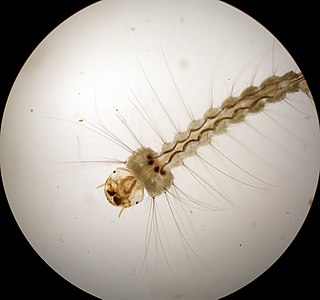
In zoology, an inquiline is an animal that lives commensally in the nest, burrow, or dwelling place of an animal of another species. For example, some organisms, such as insects, may live in the homes of gophers or the garages of humans and feed on debris, fungi, roots, etc. The most widely distributed types of inquiline are those found in association with the nests of social insects, especially ants and termites – a single colony may support dozens of different inquiline species. The distinctions between parasites, social parasites, and inquilines are subtle, and many species may fulfill the criteria for more than one of these, as inquilines do exhibit many of the same characteristics as parasites. However, parasites are specifically not inquilines, because by definition they have a deleterious effect on the host species, while inquilines have not been confirmed to do so.

Nepenthes rajah is a carnivorous pitcher plant species of the family Nepenthaceae. It is endemic to Mount Kinabalu and neighbouring Mount Tambuyukon in Sabah, Malaysian Borneo. Nepenthes rajah grows exclusively on serpentine substrates, particularly in areas of seeping ground water where the soil is loose and permanently moist. The species has an altitudinal range of

Nepenthes rafflesiana, or Raffles' pitcher-plant, is a species of tropical pitcher plant. It has a very wide distribution covering Borneo, Sumatra, Peninsular Malaysia, and Singapore. Nepenthes rafflesiana is extremely variable, with numerous forms and varieties described. In Borneo alone, there are at least three distinct varieties. The giant form of this species produces enormous pitchers rivalling those of N. rajah in size.
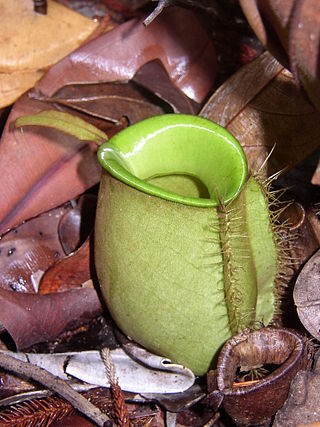
Nepenthes ampullaria is a very distinctive and widespread species of tropical pitcher plant, present in Borneo, the Maluku Islands, New Guinea, Peninsular Malaysia, Singapore, Sumatra, and Thailand.
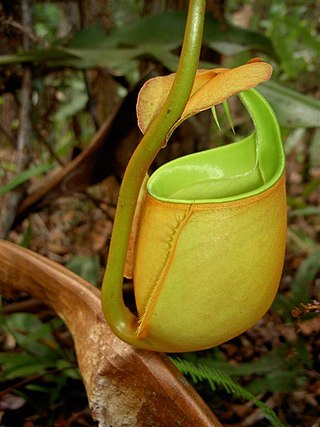
Nepenthes bicalcarata, also known as the fanged pitcher-plant, is a tropical pitcher plant endemic to northwestern Borneo, Indonesia. It is a myrmecophyte noted for its mutualistic association with a species of ant, Camponotus schmitzi. As an ant-fed plant it lacks many of the features that characterise the carnivorous syndrome in Nepenthes, including viscoelastic and highly acidic pitcher fluid, the waxy zone of the pitcher interior, and possibly even functional digestive enzymes.

Nepenthes mirabilis, or the common swamp pitcher-plant and tropical pitcher plant, is a carnivorous plant species. By far the most widespread of all Nepenthes, its range covers continental Southeast Asia and all major islands of the Malay Archipelago, stretching from China in the north to Australia in the south. The species exhibits great variability throughout its range. One of the more notable varieties, N. mirabilis var. echinostoma, is endemic to Borneo and possesses an extremely wide peristome.
Dr. Charles M. Clarke is an ecologist and botanist specialising in the carnivorous plant genus Nepenthes, for which he is regarded as a world authority. Clarke has an honours degree in Botany from Monash University in Melbourne, and a Ph.D. in Ecosystem management at the University of New England, in Armidale, New South Wales.

Nepenthesinfauna are the organisms that inhabit the pitchers of Nepenthes plants. These include fly and midge larvae, spiders, mites, ants, and even a species of crab, Geosesarma malayanum. The most common and conspicuous predators found in pitchers are mosquito larvae, which consume large numbers of other larvae during their development. Many of these animals are so specialised that they cannot survive anywhere else, and are referred to as nepenthebionts.

Nepenthes khasiana is an endangered tropical pitcher plant of the genus Nepenthes. It is the only Nepenthes species native to India. It is thought to attract prey by means of blue fluorescence.
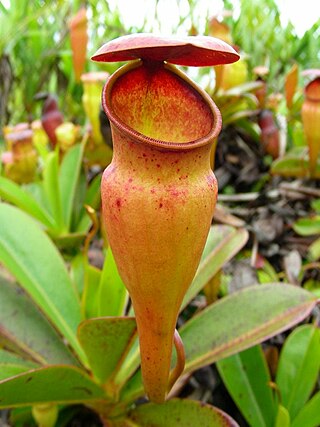
Nepenthes pervillei is the only pitcher plant found in the Seychelles, where it is endemic to the islands of Mahé and Silhouette. It grows in rocky areas near granitic mountain summits, its roots reaching deep into rock fissures. The species has an altitudinal range of 350–750 m above sea level. Like all members of the genus, N. pervillei is dioecious, having separate male and female plants.

Nepenthes madagascariensis is one of two Nepenthes pitcher plant species native to Madagascar, the other being N. masoalensis.

Nepenthes alata is a tropical pitcher plant endemic to the Philippines. Like all pitcher plants, it is carnivorous and uses its nectar to attract insects that drown in the pitcher and are digested by the plant. It is highly polymorphic, and its taxonomy continues to be subject to revisions.
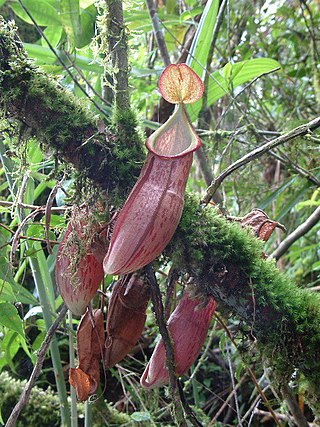
Nepenthes gymnamphora is a tropical pitcher plant native to the Indonesian islands of Java and Sumatra. It has a wide altitudinal range of 600–2,800 metres (2,000–9,200 ft) above sea level. There is much debate surrounding the taxonomic status of this species and the taxa N. pectinata and N. xiphioides.

Phytotelma is a small water-filled cavity in a terrestrial plant. The water accumulated within these plants may serve as the habitat for associated fauna and flora.
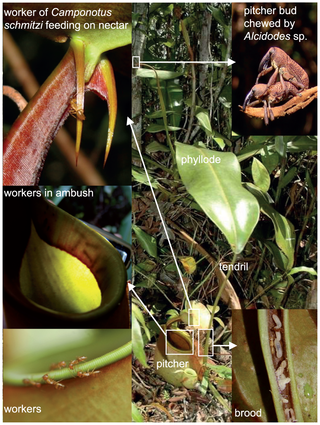
Colobopsis schmitzi, synonym Camponotus schmitzi, is a species of ant native to Borneo, which is commonly known as the diving ant, swimming ant or pitcher-plant ant, due to their habit of diving into the digestive fluids of their plant host Nepenthes bicalcarata. They are endemic to the island of Borneo.

Jacobsoniidae are a family of tiny beetles belonging to Staphylinoidea. The larvae and adults live under bark, in plant litter, fungi, bat guano and rotten wood. There are around 28 described species in three genera:
References
- ↑ Smith, Anthony (1971). Mato Grosso, last virgin land. Michael Joseph. p. 284. OCLC 191973258.
- ↑ Beaver, R. A. (June 1974). "Intraspecific Competition among Bark Beetle Larvae (Coleoptera: Scolytidae)". Journal of Animal Ecology. 43 (2). British Ecological Society: 455–467. doi:10.2307/3376. JSTOR 3376. S2CID 88217243.
- ↑ Beaver, R. A. (September 1979). "Host specificity of temperate and tropical animals". Nature . 281 (5727): 139–141. Bibcode:1979Natur.281..139B. doi:10.1038/281139a0.
- ↑ Beaver, R. A. (1986). "The taxonomy, mycangia and biology of Hypothenemus curtipennis (Schedl), the first known cryphaline ambrosia beetle (Coleoptera: Scolytidae)". Insect Systematics & Evolution. 17 (1). Brill: 131–135. doi:10.1163/187631286X00189. ISSN 1399-560X.
- ↑ Shaw, Scott Richard; Jocelyn A. Berry (December 2005). "Two new Cryptoxilos species (Hymenoptera : Braconidae : Euphorinae) from New Zealand and Fiji parasitising adult Scolytinae (Coleoptera)". Invertebrate Systematics. 19 (5). CSIRO Publishing: 371–381. doi:10.1071/IS05021.